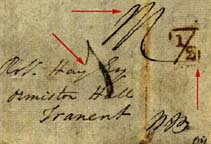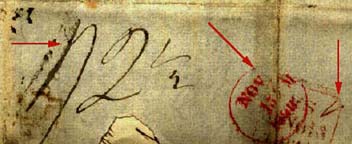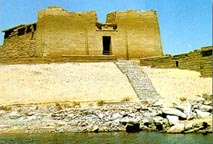Eunice and Ron Shanahan have shared with readers of the Victorian Web this material from their website, Letters from the Past. Click on thumbnails for larger images.
This is an interesting letter that I bought because it had a boxed 'Additional ½d' postmark on it, which I needed. The letter was written by Joseph John Scoles, and is dated "Argyll Place, November 13, 1838" It is addressed to "Robert Hay Esq, Ormiston Hall, TRANENT." This is a town about 10 miles southeast of Edinburgh, and was one of the Edinburgh Penny Post offices.
Postal Markings
There are six postal markings on the letter:

On the front of the letter
- manuscript charge mark of 1/1 = 1 shilling and one penny for a distance between 300 and 400 miles - Edinburgh is 396 miles from London). In the same writing and ink the letters NB were added to the address, apparently signifying North Britain.
- a boxed 'additional ½d' applied as the letter was going to Scotland, and so carried an extra ½d which was charged on every letter carried by a stage coach with more than two wheels over a Toll road in Scotland from 1813-1840.
- a black hand-struck 1. This would be the charge mark for the Edinburgh Penny Post for delivery to Tranent.

On the front of the letter
- a red Maltese Cross datestamp for the London Branch Office Vere Street, dated November 13, 1838. During the 1830's these Branch Office datestamps were only applied to General Post letters originating in London, but addressed to places outside of London. Vere street was one of four General Post Office Branch Offices opened in 1829 to ease the load on the London Head Office in St Martins le Grand. At that time most of the outgoing mail was carried in 28 mail coaches that left the General Post Office Headquarters at 8.00 pm every night to all parts of Great Britain.
- a red circular receiving date stamp for Edinburgh dated November 15, 1838
- another manuscript charge mark - this time 1/2-1/2. This is evidently the total cost of the letter.
With the increased prosperity and literacy of the population, the amount of mail handled necessitated some reorganisation. The Branch offices received the mail, datestamped it and roughly sorted it before it was forwarded to the Head Office for despatch
These postal markings were a surprising bonus, as I had bought it "sight unseen" from an English dealer's list, which had only mentioned the 'additional ½d' mark.
The Letter
The contents of the letter itself were also very interesting. Most of our letters were written by 'non-famous' people, but this one is different, because nearly all of the people mentioned in the letter were notable at that time. The Librarian of the Royal Institute of British Architects in London very kindly sent me biographical details of the architects mentioned. The writer, Joseph John Scoles was born in London on 27 June 1798, and at the time this letter was written, was engaged in designing St George's at Edgbaston, Birmingham; St. James's Church at Colchester; the observatory at Stonyhurst College, Lancashire and St. Mary's Church Newport Monmouthshire. I thought that the Bonomi referred to was Ignatius Bonomi 1787-1870 a member of the Institute of British Architects.
"My Dear Sir,
Bonomi promised to write by return of post and to reply for me to your letter of 21 Oct. But as I do not suppose he gave you much insight into the affairs in question, I take the first opportunity of writing.
Bonomi started last Friday week accompanied by his 2 sisters and a female friend of theirs, they were to leave Paris on the 8th for Rome. He wrote on the 7th in good spirits and was mightily pleased at meeting with his old camel which he gave to Burton. He made him go on his knees twice to the surprise of the keepers and the spectators without the paling [on the other side of the fence]. The animal had almost forgotten the word "KISH".
"There was nothing the matter with Bonomi his lungs are not at all affected but he became fidgity and wanted a change of scene and his various commissions put him out. The Commissions required exertions on his part and it became a task to perform them. He was bilious and dreaded the winter — he proposes returning in May with his sisters. He has given away all his goods and chattels.
The Egyptian architectural drawings are left to Mr. Burton, Mr Jones, Myself and then to the Institute of British Architects. Burton has them all at present. You are to have a cast of the camel with the rider on its back — a small packet of drawings are in my care addressed to you.
"To proceed to business. I shall have great pleasure in looking after the workshop and as it were, placing myself in the midst of the Kalabsha bas-reliefs.
"Malerti has not been at work for you these 2 or 3 weeks. He has been at Mr Jones's but will resume on Monday, I expect. Before Bonomi gave up his stewardship he had paid on your account to Malerti £4.9.0d, which is turned over to me and you also are indebted to Malerti for 1 or 2 weeks since then, but as he has not been at work since I commenced my stewardship I have not received as yet his account. There is also a caprenters bill of £1.16.2d owing up to June 24th and as far as I know these are the liabilities on your account.
Mr Haliburton had not seen Jones when he called therefore I have neither received nor paid any money for you - Mr Haliburton is suffering from a cold caught on Lord Mayor's Day.
Mahommed the black will start for his journey to the Nile sources by the first opportunity. Arundale was married 3 weeks since to one of the Miss Pickersgills, a daughter of the Royal Academician.
I am dear sir, yours, very truly,
J.J. Scoles."

Kalabsha the largest freestanding temple of Egyptian Nubia; it was one of the monuments moved for the building of the Aswan Dam. For images of postage stamps that have been issued to commemorate the huge task of moving the Nubian monuments click here
Unfortunately, the R.I.B.A does not appear to have received any of the Egyptian drawings referred to in this letter. I wonder where they finally came to rest.
Now for the next part of the story. I have made contact with Sheila Evers of England, who has interests in the Assyrians. Sheila has carried out some great detective work, which makes it seem much more likely that this is in fact Joseph Bonomi and not his father, Ignatius. This in turn has produced an entirely different interpretation of the contents of the letter taking the emphasis off architecture, and placing it firmly into Egyptology. In fact, the most definite pointer to a link with Egypt rather than architects, was the person to whom the letter was addressed the prosperous Scotsman Robert Hay. From there, the links just kept coming Bonomi to Hay ; then Hay to Scoles ; another from Hay to Owen Jones.
The Librarian of RIBA advised me that the Burton referred to in the letter as 'Burton' but then amended to 'Haliburton' was probably Decimus Burton (1800-1881) who was also a member of the Institute. But with the rest of the links in this letter being with Egyptologists, it seems likely that this may in fact be James Haliburton, for whom Sheila found yet another interesting link. She suggests that in view of the Egyptian links, these drawings may possibly be in the British Museum (Department of Egyptology) or in view of Joseph Bonomi and Hay's connection with it, in the Soane Museum.
Surprisingly, (considering the letter was written in 1838) the links below will take you directly to available information concerning the people mentioned in this letter. I would not have known of any of these links, and it was pure serendipity that I contacted Sheila when she was researching something else connected with Egypt.
Related Material
Last modified 10 December 2002